If you’ve never had challah, spring is the perfect time to give it a try. This rich, puffy bread makes a gorgeous centerpiece on your table thanks to its golden-brown good looks and the skill with which it’s braided before baking. It usually has a hint of sweetness, and it also incorporates eggs for richness. It’s a wonderful staple of the Easter season, and this unique bread has a rich religious history.
Challah in the Jewish Tradition
Challah is a ceremonial bread used during the Jewish Sabbath — which is Friday night and all day Saturday — and holy days. For Sabbath dinner, there is a double loaf, which symbolizes the Israelites’ time in the desert. They survived as a people thanks to the blessing of manna from heaven, but manna did not fall on the Sabbath. Instead, a double portion fell the day before — hence the double loaf on Friday nights. Challah is not eaten during Passover, however, because it is leavened, but can be enjoyed again once Passover is over.
Challah in the Christian Tradition
Because Passover and Easter are so closely connected — the Last Supper was originally a Passover meal, after all — it’s not surprising that both faiths enjoy challah at this time of year. While Jews may once again eat challah after Passover ends, this date also coincides with the Christian tradition of celebrating Easter with eggs. Italian “Easter bread” is a special loaf of sweet challah with dyed eggs nestled into the braids for a festive twist on the tradition.
Whether you are planning a special Easter celebration, a Friday Sabbath or simply a Saturday breakfast with French toast made from a rich loaf of challah, you’re sure to love eating our version of this springtime staple as much as we love preparing it!



